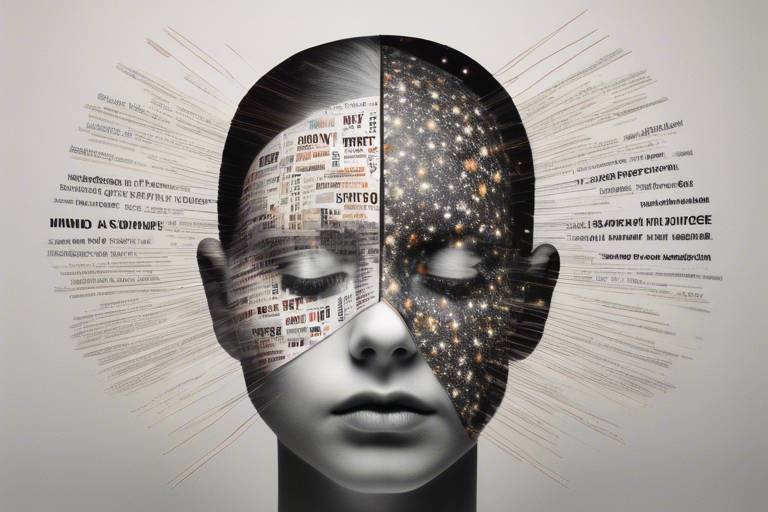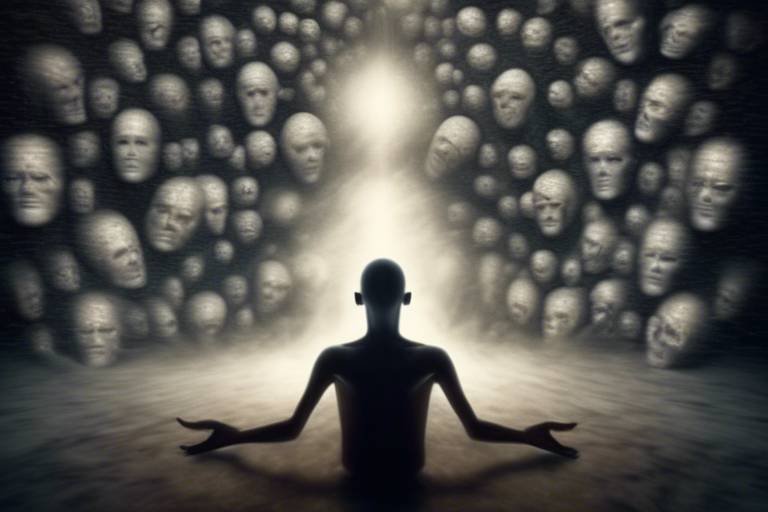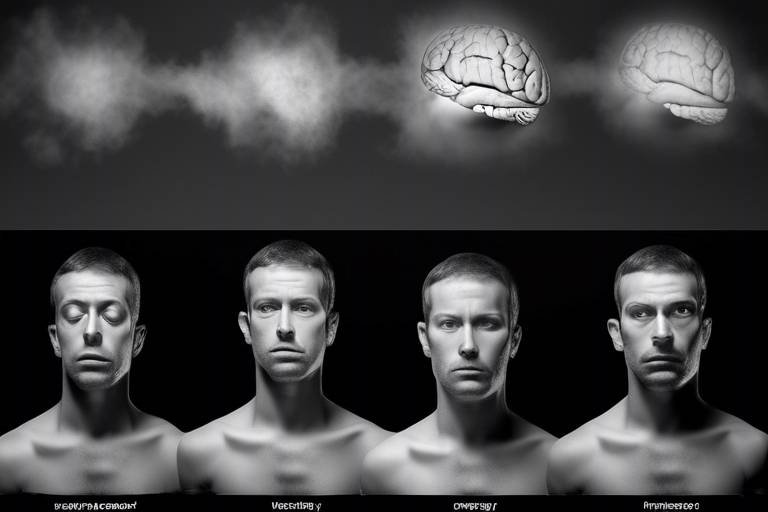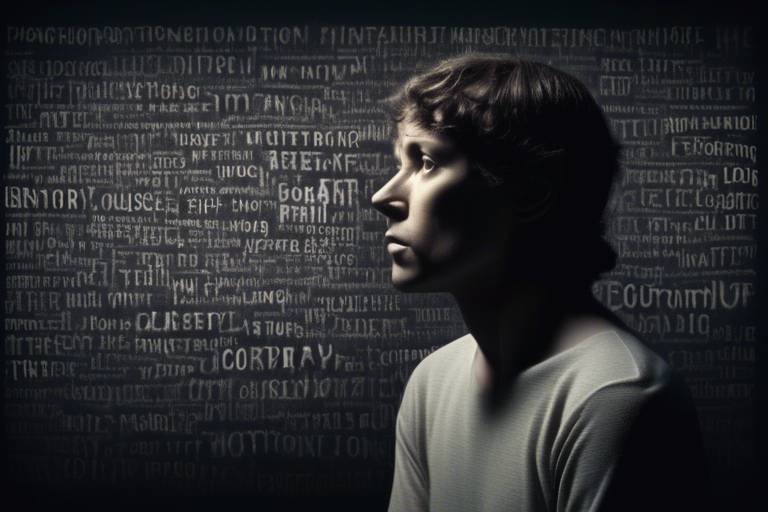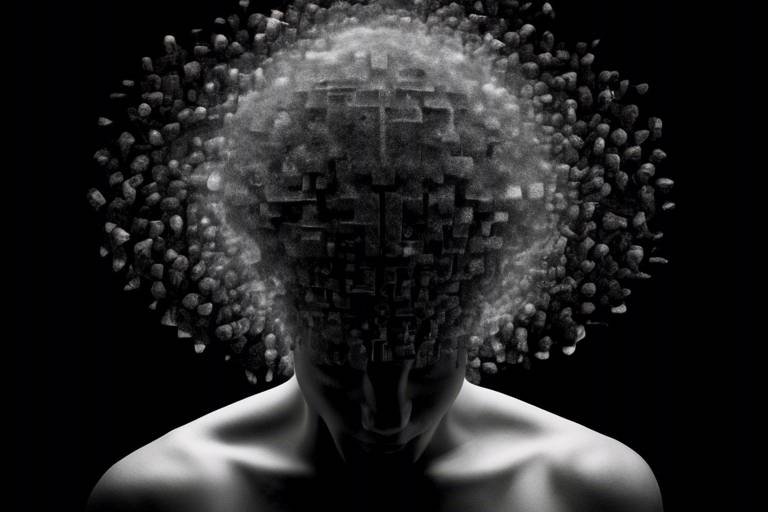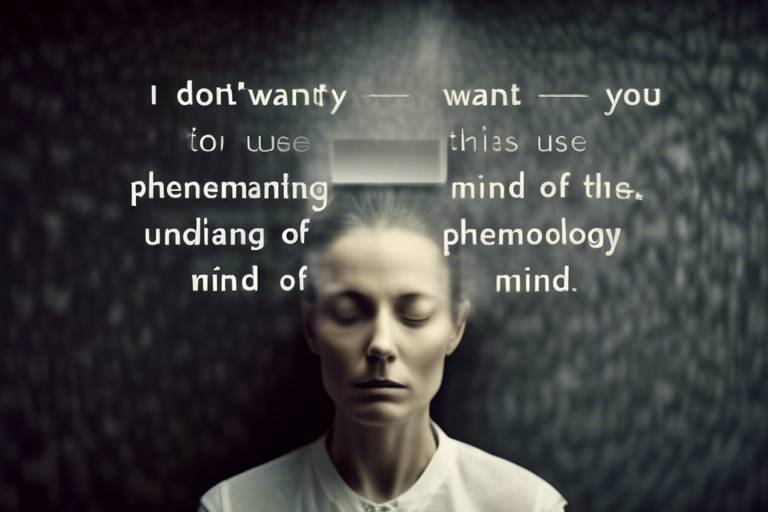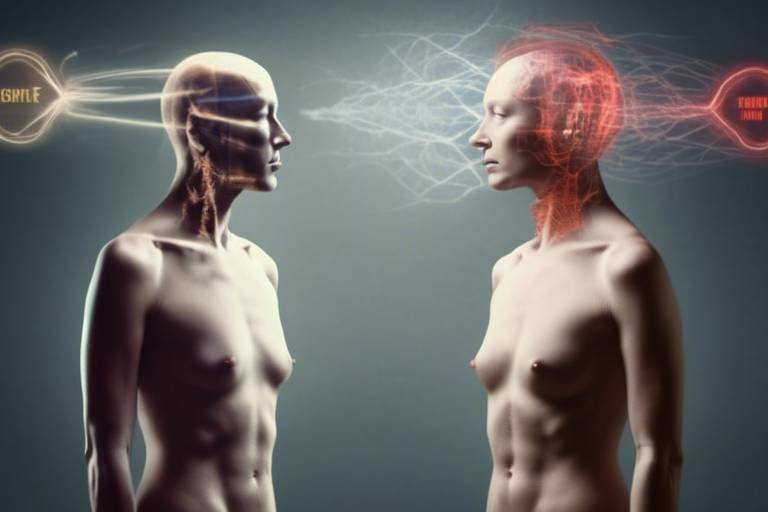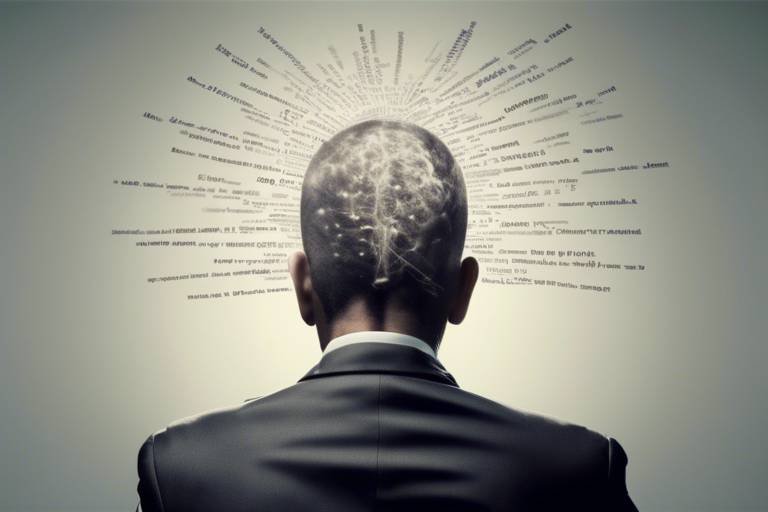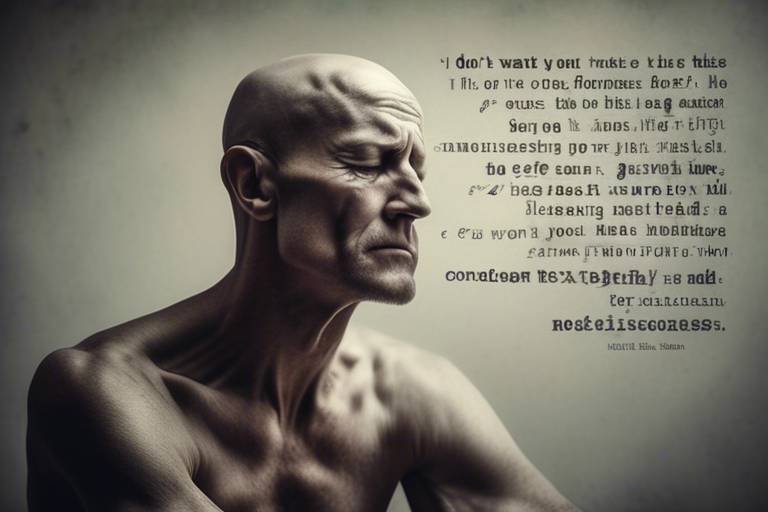The Influence of Art on Consciousness
Art is not just a collection of pretty pictures or captivating melodies; it is a powerful force that shapes our perception, emotions, and consciousness in ways we often overlook. Imagine walking into a gallery, the air thick with the scent of paint and possibility, and suddenly feeling a rush of emotions as you gaze upon a vibrant canvas. That’s the magic of art—it speaks to our innermost selves, igniting feelings and thoughts that may have been buried deep within us. In this article, we will explore the intricate relationship between art and consciousness, delving into how artistic expression transforms our human experience.
Art often serves as a mirror reflecting societal values and beliefs, providing a window into the cultural consciousness of a time. When we look at a piece of art, we’re not just seeing the artist’s vision; we’re witnessing a snapshot of the zeitgeist, the spirit of the age. Think about famous works like Picasso's "Guernica," which captures the horrors of war and the collective trauma of a society. Such pieces don’t just entertain; they provoke thought, spark conversations, and influence collective identity. The stories told through art can challenge norms, inspire movements, and even reshape societal values.
Have you ever noticed how a beautiful piece of music or a stunning painting can lift your spirits? The psychological effects of art are profound, affecting our mood and cognitive functions in remarkable ways. Engaging with art can alter our mental states, providing an escape from reality or a means to confront our deepest fears. For many, art becomes a sanctuary—a place where emotions can be explored and expressed without judgment. Studies show that interacting with art can lead to increased feelings of happiness and well-being, promoting emotional healing and cognitive clarity.
Art therapy has emerged as a powerful tool in the realm of mental health treatment. This therapeutic approach harnesses the creative process to facilitate healing and self-discovery. Imagine a person struggling with anxiety, picking up a paintbrush and finding solace in the act of creation. Through artistic expression, individuals can communicate feelings that are often difficult to articulate verbally. Art therapy provides a safe space for exploration, allowing individuals to confront their emotions, process trauma, and ultimately find a path to recovery.
Real-life examples illustrate the effectiveness of art therapy across various populations. Consider a group of veterans suffering from PTSD. Through guided art sessions, they create visual representations of their experiences, enabling them to confront and process their trauma. In another case, children with autism use art to express themselves in ways that verbal communication may not allow. These case studies highlight art therapy's role in recovery and emotional well-being, showcasing its transformative power.
Art therapists employ a variety of techniques to help individuals express feelings that are challenging to verbalize. Techniques may include:
- Painting and drawing
- Collage-making
- Clay modeling
- Creative writing
Each method serves as a unique outlet for self-expression, allowing individuals to explore their thoughts and emotions in a non-threatening manner. The beauty of art therapy lies in its adaptability; it can be tailored to meet the needs of each individual, fostering a sense of empowerment and agency.
Art plays a crucial role in shaping personal identity. For many, artistic expression is a means to explore and communicate their sense of self. Whether through painting, music, or dance, individuals can convey their unique experiences, beliefs, and emotions. This process of creation not only helps in self-discovery but also strengthens connections with others. Think of how a song can resonate with someone, making them feel understood and less alone. Art becomes a bridge between individuals, fostering empathy and shared experiences.
The connection between art and spirituality is profound and multifaceted. Throughout history, art has been used as a means of spiritual expression, facilitating experiences that deepen one’s understanding of existence. Many cultures incorporate artistic practices into their spiritual rituals, using creativity to connect with the divine. Whether it’s through the intricate designs of mandalas or the haunting melodies of sacred music, art serves as a pathway to spiritual enlightenment.
For countless individuals, creating art is not just a hobby; it is a spiritual practice. Artists often describe their creative process as a form of meditation, a way to connect with something greater than themselves. This act of creation can evoke feelings of transcendence, allowing individuals to tap into a deeper sense of purpose and meaning. By engaging in artistic practices, people can explore their spirituality and find solace in the chaos of everyday life.
Sacred art has historically shaped spiritual consciousness across various cultures. From the grand cathedrals adorned with stained glass to the delicate sculptures found in temples, religious art influences beliefs and practices in profound ways. These works not only serve as visual representations of faith but also invite contemplation and reflection. They remind us of the beauty and complexity of our spiritual journeys, urging us to explore our beliefs and values more deeply.
As technology evolves, so does the relationship between art and consciousness. Virtual reality, augmented reality, and artificial intelligence are beginning to reshape how we experience and create art. Imagine stepping into a painting or interacting with a digital sculpture that responds to your emotions. The future holds exciting possibilities for how art can influence human perception and creativity. As we move forward, the integration of technology and art may lead to new forms of expression that challenge our understanding of consciousness.
Q: How does art impact our emotions?
A: Art can evoke a wide range of emotions by tapping into our personal experiences and memories, often leading to feelings of joy, sadness, or nostalgia.
Q: Can art therapy really help with mental health issues?
A: Yes, art therapy has been shown to be effective in helping individuals process emotions, cope with trauma, and improve overall mental well-being.
Q: Is there a spiritual aspect to creating art?
A: Many people find that creating art can be a deeply spiritual experience, allowing them to connect with their inner selves and explore their beliefs.
Q: What role does culture play in art?
A: Culture heavily influences art, as it reflects the values, beliefs, and experiences of a society at a given time, shaping both individual and collective identities.

Art as a Reflection of Society
Art is not just a collection of beautiful paintings or stunning sculptures; it serves as a mirror of society, reflecting our values, beliefs, and cultural dynamics. When we look at a piece of art, we are often peering into the soul of a time and place, understanding the collective consciousness of a community. It captures the zeitgeist—the spirit of the age—allowing us to see how societal norms and issues are expressed through creative mediums. Have you ever wondered how a painting can encapsulate the struggles of a generation? Or how a song can evoke the emotions tied to historical events? That's the power of art!
Throughout history, art has played a critical role in shaping and influencing collective identity. From the vibrant murals of the Mexican Revolution to the poignant photographs of the Civil Rights Movement, art has been a powerful tool for social commentary. It has the ability to challenge the status quo, provoke thought, and inspire change. For instance, consider the impact of street art in urban environments. Artists like Banksy have used their work to address political issues, sparking conversations that might not occur in traditional forums. In this way, art not only reflects society but also shapes it.
Moreover, art serves as a historical document, preserving the essence of different eras. For example, the Renaissance period produced masterpieces that celebrated humanism and the beauty of the natural world, while the Abstract Expressionism movement of the 20th century reflected the chaos and uncertainty of post-war life. Each brushstroke, each note of music, and each dance step tells a story about the societal context in which it was created. This connection between art and society is not merely coincidental; it is a profound relationship that continues to evolve.
In contemporary society, the relationship between art and culture has become even more intricate. With the rise of social media, artists now have a platform to share their work globally, reaching audiences far beyond their local communities. This democratization of art allows for a more diverse range of voices to be heard, enriching the cultural tapestry. However, it also raises questions about authenticity and commercialization. Is art still a genuine reflection of society when it is produced for likes and shares? This ongoing dialogue adds another layer to our understanding of art's role in society.
Furthermore, art can serve as a catalyst for social change. Activist art movements, such as Feminist Art and Environmental Art, highlight pressing issues and encourage public engagement. For instance, the “#MeToo” movement has inspired countless artists to create works that address themes of gender inequality and sexual violence. By bringing these topics into the public eye, art not only reflects societal issues but also actively participates in the dialogue surrounding them.
In conclusion, art is an essential component of our societal framework. It not only reflects our current state but also influences our future direction. The way we create, perceive, and engage with art shapes our collective identity and consciousness. So, the next time you encounter a piece of art, take a moment to consider the deeper societal narratives it may be conveying. What stories does it tell? What emotions does it evoke? Art is indeed a powerful reflection of who we are as a society.
- How does art influence societal change? Art can raise awareness about social issues, inspire movements, and foster community engagement.
- Can art reflect cultural identity? Absolutely! Art often embodies the values, beliefs, and experiences of a particular culture.
- Why is it important to study art history? Studying art history helps us understand the context behind artistic movements and how they relate to societal changes over time.

The Psychological Impact of Art
Art is not just a feast for the eyes; it’s a powerful catalyst for emotional and psychological change. When we engage with art, whether it’s through creating or simply appreciating it, we tap into a deep well of emotions and thoughts that can alter our mental state. Have you ever found yourself staring at a painting, losing track of time as you become enveloped in its colors and textures? This phenomenon is not just about aesthetics; it’s about the profound psychological impact that art can have on our minds and hearts.
Research has shown that interacting with art can evoke a wide range of emotions. From feelings of joy and serenity to sadness and nostalgia, art has the unique ability to resonate deeply with our personal experiences. For instance, a vibrant landscape might remind you of a cherished vacation, while a somber piece could evoke memories of loss. This emotional connection is what makes art a vital part of human experience, serving as a mirror reflecting our inner worlds.
Moreover, engaging with art can serve as a form of emotional release. Think of it as a pressure valve for your feelings. When words fail, art can speak volumes. This is particularly true in therapeutic settings where individuals may struggle to articulate their emotions. The act of creating art allows people to communicate feelings that are often too complex or painful to express verbally. This transformative power of art can lead to significant improvements in mental health, promoting emotional healing and resilience.
Art therapy has emerged as a powerful tool in mental health treatment, offering a unique approach to healing. Through creative expression, individuals can explore their thoughts and feelings in a safe environment. This method not only fosters self-discovery but also encourages personal growth. In art therapy sessions, clients often use various mediums—such as painting, drawing, or sculpting—to express emotions that might otherwise remain buried. This process can lead to profound insights and breakthroughs in understanding oneself.
Consider the story of a young woman who struggled with anxiety and depression. Through art therapy, she began to create abstract paintings that represented her tumultuous emotions. Over time, she found that her art became a visual diary of her healing journey, allowing her to confront and process her feelings. Such case studies highlight the effectiveness of art therapy across different demographics, showcasing its role in recovery and emotional well-being.
Art therapists employ various techniques to help individuals articulate their feelings. Some common methods include:
- Free Drawing: Encouraging spontaneous expression without the pressure of creating a 'perfect' piece.
- Collage Making: Using images from magazines to create a visual representation of one’s thoughts and feelings.
- Guided Imagery: Combining visualization with artistic creation to explore deeper emotional themes.
These techniques not only facilitate emotional expression but also nurture a sense of accomplishment and self-esteem, further enhancing the therapeutic process.
In summary, the psychological impact of art is profound and multifaceted. It serves as a bridge between our inner selves and the outside world, enabling us to navigate the complex landscape of our emotions. Whether through creating art or simply observing it, we can experience a transformative journey that enriches our lives and promotes mental well-being.
- How does art therapy work?
Art therapy works by allowing individuals to express their thoughts and emotions through creative processes, facilitating healing and self-discovery. - Can anyone benefit from art therapy?
Yes! Art therapy can be beneficial for individuals of all ages and backgrounds, regardless of artistic skill level. - What types of art are used in therapy?
Various forms of art are used, including painting, drawing, sculpture, and collage, allowing for diverse expressions of feelings.

Therapeutic Uses of Art
Art therapy is not just a trendy buzzword; it's a profound method of healing that taps into the creative spirit within us all. When we think about art, we often picture paintbrushes and canvases, but the truth is, art therapy encompasses a wide range of creative expressions including drawing, sculpture, music, and even dance. This therapeutic approach allows individuals to explore their emotions, confront their fears, and express feelings that might be too difficult to articulate in words. Imagine being able to pour your heart onto a canvas or mold your anxieties into a piece of clay; that’s the magic of art therapy.
One of the most significant aspects of art therapy is its ability to foster self-discovery. When clients engage in artistic activities, they often find themselves tapping into memories and emotions that have been buried deep within. This process can be liberating and enlightening, as it allows individuals to gain insights into their own lives. For instance, a person dealing with trauma may find that creating a visual representation of their experience helps them to process and understand their feelings better. This therapeutic journey is akin to peeling back the layers of an onion; each layer reveals something new about oneself, often leading to a sense of relief and clarity.
Moreover, art therapy is particularly effective in various settings, including hospitals, schools, and rehabilitation centers. It is used to help individuals of all ages, from children coping with the emotional aftermath of bullying to elderly patients facing terminal illnesses. The beauty of art therapy lies in its adaptability; it can be tailored to meet the unique needs of each individual. For example, children might engage in playful art activities that allow them to express their feelings without the pressure of adult expectations, while adults may focus on more structured projects that delve into personal narratives.
The therapeutic uses of art extend beyond just individual healing. Group art therapy sessions can foster a sense of community and belonging among participants. When individuals come together to create art, they share their stories and experiences, which can lead to powerful connections. This shared experience can be incredibly healing, as it reminds participants that they are not alone in their struggles. In this way, art therapy becomes a communal journey, where creativity serves as a bridge connecting diverse individuals through shared emotions and experiences.
In summary, the therapeutic uses of art are vast and varied, providing a unique avenue for healing and self-exploration. Whether through individual expression or group collaboration, art therapy opens doors to emotional healing that traditional talk therapies may not. It's a reminder that sometimes, the best way to heal is to create.
- What is art therapy? Art therapy is a therapeutic practice that uses creative processes to help individuals express their emotions, confront challenges, and promote mental well-being.
- Who can benefit from art therapy? People of all ages and backgrounds can benefit from art therapy, including children, adults, and the elderly, especially those dealing with trauma, mental illness, or emotional difficulties.
- Do you need to be an artist to participate in art therapy? No, you do not need any artistic skills or experience to benefit from art therapy. The focus is on the process of creation rather than the final product.
- How does art therapy work? Art therapy works by allowing individuals to express feelings and thoughts through creative mediums, which can lead to insights, emotional release, and healing.
- Where can I find art therapy? Art therapy can be found in various settings, including hospitals, community centers, schools, and private practices. It's essential to seek a qualified art therapist for guidance.

Case Studies in Art Therapy
Art therapy has emerged as a vital tool in the mental health field, showcasing its effectiveness through numerous case studies. These real-life examples highlight how creative expression can facilitate healing and promote emotional well-being in various populations. One notable case involved a young woman named Sarah, who struggled with severe anxiety and depression. Through art therapy, she discovered a safe space to express her feelings. By creating a series of paintings that depicted her emotional journey, Sarah was able to externalize her internal struggles. This process not only helped her gain insight into her emotions but also fostered a sense of empowerment and control over her mental health.
Another compelling case study involves a group of veterans dealing with PTSD. In a structured art therapy program, participants engaged in collaborative mural painting. This activity not only served as a creative outlet but also facilitated camaraderie among the veterans. As they shared their stories and experiences while working together, they found a sense of community and understanding that was often missing in their daily lives. The mural became a powerful symbol of their shared struggles and resilience, helping them to process trauma in a supportive environment.
In addition to these examples, art therapy has also shown promise in pediatric settings. For instance, a case involving a child with autism illustrates the transformative power of art. The child, initially non-verbal, began to communicate through drawing. His therapist noted that as he created images of his feelings, he started to articulate his thoughts verbally. This breakthrough not only enhanced his communication skills but also allowed him to connect with his peers in a meaningful way.
These case studies underline the diverse applications of art therapy across different demographics and mental health challenges. They demonstrate that whether it’s through painting, drawing, or other forms of artistic expression, the therapeutic process can lead to profound personal insights and emotional healing. As more individuals experience the benefits of art therapy, the demand for trained art therapists continues to grow, emphasizing the need for this unique approach in mental health treatment.
- What is art therapy? Art therapy is a therapeutic practice that uses creative processes to help individuals express themselves and explore their emotions.
- Who can benefit from art therapy? People of all ages and backgrounds can benefit from art therapy, especially those dealing with mental health issues, trauma, or emotional challenges.
- What materials are used in art therapy? Art therapists may use a variety of materials, including paints, markers, clay, and collage materials, depending on the individual's preferences and therapeutic goals.
- Is art therapy effective? Yes, numerous studies and case reports indicate that art therapy can be effective in promoting emotional healing and personal growth.

Techniques in Art Therapy
Art therapy is an incredibly versatile and dynamic field that employs a variety of techniques to help individuals express their thoughts and emotions in ways that words often cannot. One of the most common techniques is drawing and painting, which allows clients to visualize their feelings and experiences. Imagine a child who has difficulty articulating their fears; a simple act of drawing can transform those abstract feelings into tangible images, providing a window into their emotional world.
Another powerful technique is collage-making, where clients cut out images and words from magazines to create a visual narrative that represents their inner thoughts. This method can be particularly effective for those who struggle with verbal communication, as it encourages them to piece together their story without the pressure of forming sentences. The act of creating a collage can also serve as a metaphor for life itself—sometimes, we must gather various elements to create a cohesive picture.
Additionally, sculpting can be a profound way to engage with emotions. By manipulating materials like clay or play-dough, individuals can express feelings that may be difficult to articulate verbally. This tactile experience can be incredibly grounding, allowing clients to physically shape their emotions and thoughts. For example, someone dealing with grief might create a sculpture that represents their loss, providing a sense of release and understanding.
Incorporating music and movement into art therapy sessions is another technique that can enhance emotional expression. Music can evoke memories and emotions, serving as a catalyst for deeper exploration. Clients might be encouraged to draw or paint while listening to specific pieces of music, allowing the rhythms and melodies to guide their creative process. Movement, on the other hand, can release pent-up emotions, and clients may engage in dance or other forms of physical expression as part of their therapeutic journey.
Moreover, guided imagery is a technique where therapists lead clients through visualizations that promote relaxation and introspection. For instance, a therapist might ask a client to imagine a peaceful place and then encourage them to create an artwork that represents that space. This method not only fosters a sense of calm but also encourages clients to explore their inner landscape, revealing insights about their emotional state.
Ultimately, the beauty of art therapy lies in its adaptability. Each individual is unique, and therapists often tailor their approaches to meet the specific needs and preferences of their clients. Whether through painting, sculpting, collage-making, or movement, art therapy offers a rich tapestry of techniques that can lead to profound personal insights and emotional healing.
- What is art therapy? Art therapy is a therapeutic practice that uses creative expression to help individuals explore their emotions, improve mental health, and enhance personal development.
- Who can benefit from art therapy? People of all ages and backgrounds can benefit from art therapy, including those dealing with trauma, anxiety, depression, and other mental health issues.
- Do I need to be an artist to participate in art therapy? No! Art therapy is about the process of creation, not the final product. Participants do not need any artistic skills or experience.
- How does art therapy work? Art therapy works by providing a safe space for individuals to express their feelings through creative means, which can lead to insights and healing.

The Role of Art in Personal Identity
Art is not just a form of expression; it is a powerful vehicle through which individuals can explore and communicate their personal identity. When we engage in artistic practices, whether through painting, writing, or performing, we often find ourselves delving into the depths of our thoughts, feelings, and experiences. This journey can be transformative, allowing us to connect with our inner selves and articulate aspects of our identity that might otherwise remain unspoken.
Consider the act of creating art as a mirror reflecting our internal landscape. Each brushstroke, word, or note can symbolize a facet of who we are. For instance, a painter might use bold colors and dynamic forms to express their vivacious personality, while a poet may choose softer, more introspective language to convey their contemplative nature. In this way, art becomes a language of self-discovery, enabling individuals to communicate their unique narratives to the world.
Moreover, art can serve as a catalyst for personal growth. Engaging with various artistic mediums encourages individuals to confront their emotions and experiences, fostering a deeper understanding of themselves. This process can be particularly beneficial during transitional phases in life, such as adolescence or major life changes, where individuals are often seeking to define or redefine their identities. Through art, they can explore their values, beliefs, and aspirations, ultimately leading to a more cohesive sense of self.
In addition, art plays a significant role in shaping our cultural identity. It connects us to our heritage and community, allowing us to express shared experiences and collective memories. For example, traditional art forms often embody the stories and struggles of a community, helping individuals feel a sense of belonging and continuity. This connection can be particularly empowering, as it reinforces the idea that our identities are not formed in isolation but are intertwined with the larger narratives of those around us.
Furthermore, the act of sharing art can also enhance personal identity. When individuals present their work to others, they invite feedback and interpretation, which can further shape their understanding of themselves. This interaction can lead to a sense of validation and recognition, affirming their place in the world. In this sense, art becomes a dialogue—a way to engage with both oneself and the broader community.
To illustrate the multifaceted role of art in personal identity, let's examine a few key points:
- Self-Expression: Art allows individuals to express feelings and thoughts that might be difficult to articulate verbally.
- Personal Growth: Engaging with art can lead to self-discovery and personal development.
- Cultural Connection: Art connects individuals to their heritage and community, reinforcing a sense of belonging.
- Feedback and Validation: Sharing art with others can provide affirmation and recognition of one's identity.
In conclusion, the role of art in shaping personal identity is profound and multifaceted. It serves as a means of exploration, a tool for self-discovery, and a bridge connecting individuals to their cultural roots. Through the act of creating and sharing art, we not only express who we are but also invite others to witness our journey of identity formation.
- How does art help in self-discovery?
Art allows individuals to explore their thoughts and emotions, providing a safe space to confront personal issues and gain insights into their identity. - Can anyone use art to express their identity?
Absolutely! Art is a universal language that can be utilized by anyone, regardless of skill level, to express their unique experiences and perspectives. - What types of art are best for exploring personal identity?
Any form of art can be beneficial, including painting, writing, music, and dance. The key is to choose a medium that resonates with you personally.

Art and Spirituality
The connection between art and spirituality is profound and often transformative. Art serves as a bridge between the tangible and the intangible, allowing individuals to express feelings and experiences that may be difficult to articulate in words. This relationship is not just a modern phenomenon; it has roots in ancient cultures where art was used as a medium for spiritual expression and connection to the divine. Think about it: when you look at a beautiful painting or hear a moving piece of music, doesn't it feel like you are tapping into something greater than yourself? This is the magic of art—it has the power to elevate our consciousness and connect us to a deeper sense of existence.
Throughout history, various cultures have utilized art as a means of spiritual expression. For instance, in Eastern traditions, practices such as calligraphy and mandala creation are not merely artistic endeavors; they are spiritual practices that facilitate meditation and self-reflection. Similarly, in Western traditions, religious art has played a critical role in conveying spiritual narratives and ideals. From the intricate stained glass windows of Gothic cathedrals to the serene imagery found in Renaissance paintings, these artworks have served not just as decorations, but as conduits for spiritual connection.
Moreover, art can facilitate profound spiritual experiences. Many individuals report feeling a sense of transcendence or connection to the universe when engaging with art. This phenomenon can be attributed to the way art stimulates our emotions and senses, often leading to moments of introspection and enlightenment. For example, a person might find themselves lost in the colors and forms of a painting, prompting them to reflect on their own life journey and beliefs. In this way, art becomes a tool for personal and spiritual exploration.
To further illustrate the relationship between art and spirituality, consider the following aspects:
- Art as a Reflection of Beliefs: Many artists draw inspiration from their spiritual beliefs, infusing their works with symbols and themes that resonate with their faith.
- Art as a Meditative Practice: Creating art can be a meditative act, allowing individuals to enter a state of flow where they can connect with their inner selves.
- Art in Rituals: Many cultures incorporate art into rituals and ceremonies, using it as a way to honor the divine and mark significant life events.
In conclusion, the interplay between art and spirituality is a rich tapestry that enhances our understanding of both. As we navigate through life, engaging with art can provide us with insights into our own spirituality, helping us to explore questions of existence, purpose, and connection. So the next time you find yourself captivated by a piece of art, take a moment to reflect on the deeper meanings it may hold for you. It might just lead you to a greater understanding of yourself and the world around you.
Q: How does art influence spiritual beliefs?
A: Art often reflects and shapes spiritual beliefs by visually representing concepts that are central to various faiths, allowing individuals to connect with their spirituality in a tangible way.
Q: Can creating art be considered a spiritual practice?
A: Yes, many people find that the process of creating art allows them to enter a meditative state, facilitating a deeper connection to their inner selves and spirituality.
Q: What role does art play in religious rituals?
A: Art plays a significant role in religious rituals by serving as a medium for expressing devotion, marking important life events, and creating a sacred atmosphere.

Art as a Spiritual Practice
Art has long served as a profound spiritual practice across various cultures and traditions. It acts as a bridge between the mundane and the transcendent, allowing individuals to express their innermost thoughts, feelings, and beliefs in a tangible form. Through the act of creation, artists often find themselves on a journey of self-discovery, where each brushstroke or chisel mark becomes a meditation on existence itself. This connection to spirituality can be both personal and communal, as art has the power to unite people in shared experiences and beliefs.
Many cultures incorporate artistic expression into their spiritual rituals. For instance, Indigenous cultures often use ceremonial art—like totem poles or sand paintings—as a means to connect with their ancestors and the spiritual world. These artworks are not merely decorative; they serve as vessels of meaning, embodying stories, teachings, and the very essence of the community's identity. Similarly, in the realm of Eastern spirituality, practices such as mandala creation or calligraphy are seen as meditative acts that facilitate a deeper understanding of the universe and one's place within it.
Artistic practices can also be a form of prayer or devotion. For many, the act of creating is akin to worship. It becomes a way to channel spiritual energies and express gratitude or longing. For example, the intricate designs of Islamic art are not just visually stunning; they are imbued with spiritual significance, reflecting the infinite nature of the divine. The repetitive patterns and vibrant colors can induce a state of trance, leading the creator or the viewer to a deeper spiritual awareness.
Furthermore, the process of creating art can be therapeutic. Engaging in artistic activities allows individuals to explore their emotions and experiences in a safe space. This can lead to profound insights and a greater sense of peace. For example, during times of grief, people might turn to art as a means of processing their feelings. They might create a painting that captures their sorrow or sculpt a piece that represents their healing journey. In this way, art acts not only as a form of expression but also as a catalyst for spiritual growth.
Moreover, art can serve as a communal practice that enhances spiritual connections among groups. Whether through group painting sessions, collaborative murals, or community art projects, these activities foster a sense of belonging and shared purpose. Participants often find that working together on a creative endeavor strengthens their bonds and deepens their understanding of one another’s spiritual journeys. This collective experience can transform a simple act of creation into a powerful ritual that celebrates life, connection, and the divine.
In conclusion, art as a spiritual practice encompasses a wide range of expressions and experiences that transcend mere aesthetics. It invites individuals to explore their inner worlds, connect with others, and engage with the mysteries of existence. As we continue to evolve, the intersection of art and spirituality will undoubtedly remain a vital aspect of the human experience, reminding us of our shared quest for meaning and connection in an ever-changing world.
- What is the relationship between art and spirituality? Art serves as a medium through which individuals can explore and express their spiritual beliefs, connecting the material and the transcendent.
- Can art be therapeutic? Yes, engaging in artistic practices can provide emotional relief and facilitate healing, allowing individuals to process complex feelings.
- How does art foster community? Collaborative art projects create shared experiences that enhance connections among individuals, promoting a sense of belonging and collective identity.
- Are there specific art forms associated with spirituality? Various art forms, such as mandalas, sacred geometry, and ceremonial crafts, are deeply rooted in spiritual traditions and practices.

The Influence of Sacred Art
Sacred art has been a cornerstone of human civilization, acting as a bridge between the material and spiritual worlds. Throughout history, it has shaped not only individual beliefs but also collective cultural identities. When we think about sacred art, we often envision stunning cathedrals adorned with intricate stained glass windows, or ancient sculptures that seem to breathe life into the stories of deities and saints. But what is it about sacred art that resonates so deeply within the human spirit? It’s more than just aesthetics; it’s a profound expression of faith, community, and the search for meaning in our existence.
At its core, sacred art serves as a visual language that transcends words. It captures the essence of spiritual beliefs and rituals, allowing individuals to connect with the divine in a tangible way. For instance, consider how the vibrant colors and detailed imagery of Hindu temples invite worshippers to immerse themselves in the stories of their gods. Similarly, the serene expressions found in Buddhist sculptures encourage contemplation and mindfulness. Each piece of sacred art carries a narrative that speaks to the values and experiences of its culture, creating a shared sense of identity among its people.
Moreover, sacred art has the power to evoke strong emotional responses. When individuals encounter a piece of sacred art, it can stir feelings of awe, reverence, and even comfort. This emotional connection can lead to a deeper understanding of one’s faith and a more profound appreciation for the mysteries of life. In many ways, sacred art acts as a catalyst for spiritual experiences, encouraging individuals to reflect on their beliefs and the world around them.
To illustrate the impact of sacred art, let’s explore some key influences:
- Community Identity: Sacred art often reflects the values and traditions of a community, reinforcing a collective identity. For example, Native American totem poles tell stories of ancestry and spirituality, serving as a reminder of cultural heritage.
- Ritual and Worship: Many religious practices are intertwined with sacred art. Icons, altars, and mandalas play significant roles in rituals, helping individuals focus their intentions and connect with the divine.
- Education and Morality: Sacred art often conveys moral lessons or religious teachings. Through visual storytelling, it educates followers about their faith and encourages them to embody its principles.
As we look to the future, the influence of sacred art continues to evolve. In an increasingly secular world, many artists are reinterpreting sacred themes, blending traditional elements with contemporary styles. This fusion not only keeps sacred art relevant but also invites new interpretations and discussions about spirituality. Whether through digital installations or modern sculptures, the essence of sacred art remains a vital part of our quest for meaning and connection.
In conclusion, sacred art is more than just a reflection of religious beliefs; it is a powerful force that shapes our consciousness and influences our understanding of the world. By engaging with sacred art, we not only appreciate its beauty but also tap into the rich tapestry of human experience, spirituality, and community. As we continue to explore these connections, we find that sacred art is indeed a mirror to our souls, inviting us to delve deeper into the mysteries of existence.
- What is sacred art? Sacred art refers to artistic expressions that are created for religious or spiritual purposes, often serving as a medium to convey beliefs and values.
- How does sacred art influence spirituality? Sacred art can evoke emotions, facilitate spiritual experiences, and provide a tangible connection to the divine, enhancing one's understanding of spirituality.
- Can sacred art be modern? Yes! Many contemporary artists reinterpret sacred themes, blending traditional elements with modern techniques, making sacred art relevant in today's world.

The Future of Art and Consciousness
The relationship between art and consciousness is not static; it evolves as society progresses and technology advances. In the digital age, we are witnessing a profound transformation in how art is created, consumed, and understood. This evolution raises intriguing questions: How will emerging technologies like virtual reality (VR) and artificial intelligence (AI) shape our artistic experiences? Will these innovations enhance our consciousness or create new barriers to understanding? As we delve into the future of art, we must consider these dynamics and their implications for human perception and creativity.
One of the most exciting developments is the integration of virtual reality into the art world. Imagine stepping into a painting, where you can explore every brush stroke and color in a fully immersive environment. This technology not only alters our interaction with art but also expands our consciousness by allowing us to experience art in ways previously unimaginable. VR art installations can evoke emotions and provoke thoughts in a manner that traditional forms may struggle to achieve. They create a space where the viewer becomes part of the artwork, blurring the lines between creator and observer.
Furthermore, artificial intelligence is beginning to play a significant role in the creative process. AI algorithms can analyze vast amounts of data to generate new art forms, pushing the boundaries of creativity. While some may argue that AI-generated art lacks the emotional depth of human-created works, others see it as a new frontier that challenges our understanding of authorship and creativity. This raises an essential question: Can machines possess consciousness, or is their art merely a reflection of our own human experiences? As we navigate this uncharted territory, we must remain open-minded about the potential of technology to enhance our artistic landscape.
Moreover, the rise of social media platforms has democratized art, allowing artists from all backgrounds to share their work with a global audience. This shift has led to a more diverse representation of voices and perspectives in the art world. As we embrace this new era, we must consider how collective consciousness is shaped by these diverse narratives. Art has the power to unite individuals across different cultures, fostering empathy and understanding. The future of art is not just about individual expression; it’s also about the collective experience and how we can use art to bridge gaps between communities.
As we look ahead, it's crucial to recognize the potential of art to influence our consciousness on a societal level. Public art installations, for example, can serve as catalysts for social change, prompting conversations about pressing issues such as climate change, inequality, and mental health. These artworks can challenge viewers to reflect on their beliefs and behaviors, ultimately leading to a more conscious society. In this sense, art becomes a tool for activism, empowering individuals to take action and make a difference.
In conclusion, the future of art and consciousness is a thrilling landscape filled with possibilities. As technology continues to advance, we must remain vigilant in exploring how these changes affect our understanding of art and its role in our lives. Will we embrace these innovations to enhance our consciousness, or will we allow them to overshadow the emotional connections that art fosters? The answer lies in our willingness to engage with these developments thoughtfully and creatively, ensuring that art remains a vital part of the human experience.
- How will technology impact the future of art? Technology will enhance artistic expression through virtual reality and artificial intelligence, creating immersive experiences and new forms of creativity.
- Can AI create meaningful art? While AI can generate art, the debate continues about whether it can replicate the emotional depth found in human-created works.
- What role does social media play in the art world? Social media democratizes art, allowing diverse voices to be heard and fostering a global community of artists and art lovers.
- How can art promote social change? Art can challenge societal norms and inspire conversations about critical issues, acting as a catalyst for activism and community engagement.
Frequently Asked Questions
- How does art influence our emotions?
Art has a remarkable ability to evoke emotions. When we engage with a painting, listen to music, or watch a performance, our brains react in ways that can stir feelings of joy, sadness, nostalgia, or even anger. This emotional response is often tied to personal experiences and memories, making art a powerful tool for emotional connection.
- Can art really help in mental health recovery?
Absolutely! Art therapy has gained recognition as an effective method for mental health treatment. It allows individuals to express feelings that are often hard to articulate verbally. Through creative expression, people can explore their emotions, gain insights into their struggles, and ultimately find healing. It's like giving a voice to feelings that are stuck inside.
- What is the relationship between art and personal identity?
Art serves as a mirror to our personal identity. It helps us explore who we are and communicate our unique experiences and perspectives. Whether through painting, writing, or performing, artistic expression allows individuals to showcase their identity and connect with others on a deeper level. Think of it as a canvas where you paint your life story.
- How does sacred art impact spirituality?
Sacred art has historically played a significant role in shaping spiritual beliefs and practices. It often serves as a medium for expressing the divine and can deepen one’s understanding of spirituality. From intricate church stained glass to traditional religious paintings, sacred art invites contemplation and fosters a connection to the spiritual realm.
- What future trends might we see in the relationship between art and consciousness?
As technology advances, we can expect to see exciting developments in how art interacts with consciousness. Virtual reality, augmented reality, and AI-generated art are just a few examples of how technology might transform our artistic experiences. These innovations could redefine creativity and alter our perception of art, making it even more immersive and impactful.




